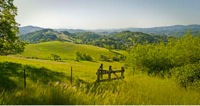Difference between revisions of "Pasture"
m (Text replacement - "http://nordan.daynal.org" to "https://nordan.daynal.org") |
m (Text replacement - "http://" to "https://") |
||
| Line 3: | Line 3: | ||
==Origin== | ==Origin== | ||
[https://nordan.daynal.org/wiki/index.php?title=English#ca._1100-1500_.09THE_MIDDLE_ENGLISH_PERIOD Middle English], from Anglo-French, from Late Latin ''pastura'', from [[Latin]] ''pastus'', past participle of ''pascere'' to feed | [https://nordan.daynal.org/wiki/index.php?title=English#ca._1100-1500_.09THE_MIDDLE_ENGLISH_PERIOD Middle English], from Anglo-French, from Late Latin ''pastura'', from [[Latin]] ''pastus'', past participle of ''pascere'' to feed | ||
| − | *[ | + | *[https://en.wikipedia.org/wiki/14th_century 14th Century] |
==Definitions== | ==Definitions== | ||
*1: [[plants]] (as grass) grown for the feeding especially of grazing [[animals]] | *1: [[plants]] (as grass) grown for the feeding especially of grazing [[animals]] | ||
| Line 9: | Line 9: | ||
*3: the feeding of livestock : grazing | *3: the feeding of livestock : grazing | ||
==Description== | ==Description== | ||
| − | '''Pasture''' (from the [[Latin]] ''pastus'', past participle of ''pascere'' ”to feed”) is land used for grazing. Pasture [[lands]] in the narrow sense are enclosed tracts of farmland, grazed by domesticated [ | + | '''Pasture''' (from the [[Latin]] ''pastus'', past participle of ''pascere'' ”to feed”) is land used for grazing. Pasture [[lands]] in the narrow sense are enclosed tracts of farmland, grazed by domesticated [https://en.wikipedia.org/wiki/Livestock livestock], such as horses, cattle, sheep or swine. The vegetation of tended pasture, [[forage]], consists mainly of grasses, with an interspersion of legumes and other [https://en.wikipedia.org/wiki/Forb forbs]. Pasture is typically grazed throughout the [[summer]], in contrast to meadow which is used for grazing only after being mown to make hay for [[winter]] fodder. |
| − | ''Pasture'' in a wider sense additionally includes [ | + | ''Pasture'' in a wider sense additionally includes [https://en.wikipedia.org/wiki/Rangeland rangelands], other unenclosed pastoral systems and [[land]] types used by wild animals for grazing or browsing. |
| − | ''Pasture'' lands in the narrow sense are distinguished from rangelands by being managed through more intensive [[agricultural]] [[practices]] of seeding, [ | + | ''Pasture'' lands in the narrow sense are distinguished from rangelands by being managed through more intensive [[agricultural]] [[practices]] of seeding, [https://en.wikipedia.org/wiki/Irrigation irrigation], and the use of fertilizers, while rangelands grow primarily [[native]] vegetation, managed with extensive practices like controlled burning and regulated intensity of grazing. |
| − | [[Soil]] type, minimum annual temperature, and [ | + | [[Soil]] type, minimum annual temperature, and [https://en.wikipedia.org/wiki/Rainfall rainfall] are important factors in pasture management. |
| − | ''Sheepwalk'' is an area of [ | + | ''Sheepwalk'' is an area of [https://en.wikipedia.org/wiki/Grassland grassland] where sheep can roam freely. The [[productivity]] of sheepwalk is measured by the number of sheep per area. This is dependent, among other things, on the underlying rock. Sheepwalk is also the name of townlands in County Roscommon, Ireland and County Fermanagh, Northern Ireland. |
| − | Prior to the advent of [ | + | Prior to the advent of [https://en.wikipedia.org/wiki/Factory_farming factory farming] with its use of "zero-grazing" feeding techniques, ''pasture'' was the primary source of food for grazing animals such as cattle and horses. It is still used extensively, particularly in arid regions where pasture land is unsuitable for any other agricultural production. In more humid regions, pasture grazing is exploited extensively for [https://en.wikipedia.org/wiki/Free_range free range] and [https://en.wikipedia.org/wiki/Organic_farming organic farming]. It is an important biotic resource. |
[[Category: General Reference]] | [[Category: General Reference]] | ||
Latest revision as of 02:22, 13 December 2020
Origin
Middle English, from Anglo-French, from Late Latin pastura, from Latin pastus, past participle of pascere to feed
Definitions
- 1: plants (as grass) grown for the feeding especially of grazing animals
- 2: land or a plot of land used for grazing
- 3: the feeding of livestock : grazing
Description
Pasture (from the Latin pastus, past participle of pascere ”to feed”) is land used for grazing. Pasture lands in the narrow sense are enclosed tracts of farmland, grazed by domesticated livestock, such as horses, cattle, sheep or swine. The vegetation of tended pasture, forage, consists mainly of grasses, with an interspersion of legumes and other forbs. Pasture is typically grazed throughout the summer, in contrast to meadow which is used for grazing only after being mown to make hay for winter fodder.
Pasture in a wider sense additionally includes rangelands, other unenclosed pastoral systems and land types used by wild animals for grazing or browsing.
Pasture lands in the narrow sense are distinguished from rangelands by being managed through more intensive agricultural practices of seeding, irrigation, and the use of fertilizers, while rangelands grow primarily native vegetation, managed with extensive practices like controlled burning and regulated intensity of grazing.
Soil type, minimum annual temperature, and rainfall are important factors in pasture management.
Sheepwalk is an area of grassland where sheep can roam freely. The productivity of sheepwalk is measured by the number of sheep per area. This is dependent, among other things, on the underlying rock. Sheepwalk is also the name of townlands in County Roscommon, Ireland and County Fermanagh, Northern Ireland.
Prior to the advent of factory farming with its use of "zero-grazing" feeding techniques, pasture was the primary source of food for grazing animals such as cattle and horses. It is still used extensively, particularly in arid regions where pasture land is unsuitable for any other agricultural production. In more humid regions, pasture grazing is exploited extensively for free range and organic farming. It is an important biotic resource.
